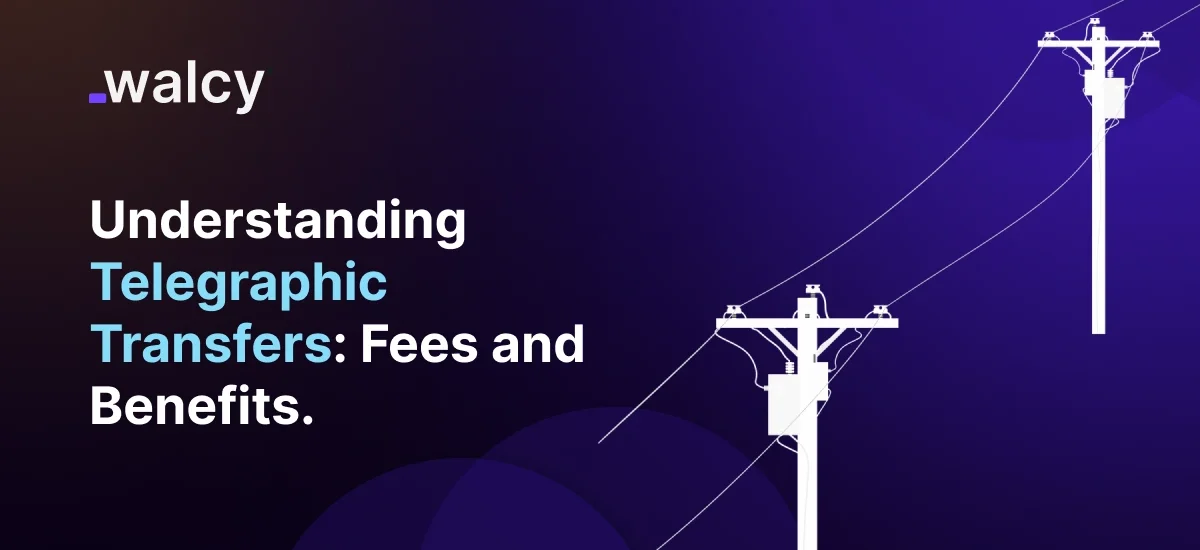Cross-border payments have never been of greater significance than they are right now, with the growing interconnectedness of countries in the global financial system.
From personal transfers to business-related ones, they must be carried out efficiently, securely, and reliably across national boundaries. One of these age-old techniques that remains effective today is the telegraph transfer. Transferring money across borders using telegraph transfers is still a popular and reliable option, even if the Digital Age has completely changed how we send and receive money.
In this blog, we will cover all about telegraphic transfers: how they work, the cost associated with them, the duration of the transfer, and even their benefits. Additionally, we discuss how the telegraphic transfer works in opposition to all the rest of the payment means to help in making the right decision when transferring funds across borders.
What is a Telegraphic Transfer?
A telegraphic transfer refers to the way of transmitting funds between accounts using a cable, radio, or get this, a transoceanic telephone, particularly between countries.
In the past, telegraphic transfers used to make use of telegraph networks for sending interbank instructions to move funds from one bank to another. However, these days it is processed via highly secured banking networks, including SWIFT (Society for Worldwide Interbank Financial Telecommunication), to guarantee speed and safety in global transfers.
Common Usages of Telegraphic Transfer
Telegraphic transfers are versatile and are used for a variety of important purposes, including but not limited to the following:
International Trade: To pay for imports, exports, or whatever global business transactions.
Personal Remittances: Sending money to family or friends abroad.
Foreign Investments: Funding Overseas Investments or buying property.
Tuition and Fees: Education or service fee payments abroad.
Read about: International Payment Fees | The Essential guide.
How Does a Telegraphic Transfer Work?
The process of a telegraphic transfer is an electronic transfer of money from one bank to another usually between countries. This process is efficient, but there are required details and a fee for accomplishing that. The following is a step-by-step guide through the procedure followed in making a TT payment:
Step 1: Initiation of transfer
The sender initiates the transfer by details of the recipient: the name, bank account number, the SWIFT/BIC code of the receiving bank, and the address of the bank. This can be facilitated through online banking, going to a bank, or even calling customer service.
Step 2: Telegraphic Transfer Fee Payment:
A telegraphic transfer fee is payable by the sender before the actual transfer. The fees vary from bank to bank, regarding the amount transferred and the destination of the transfer.
Step 3: Currency Exchange:
When necessary, the money of the transferor is converted into the recipient’s local currency according to the telegraphic transfer buying rate of exchange. Most banks charge a margin on the rate of exchange; hence the rate will be different from the mid-market rate – the actual current rate of exchange.
Step 4: Verification for Compliance:
The bank in which the originator has his account verifies the observance of AML and KYC norms. These checks establish that the transfer is legal and valid.
Step 5: Bank Transfer:
After verification, the bank starts the transfer, generally through the SWIFT network. It transfers funds from the bank account of the originator to that of the beneficiary.
Step 6: Inward Telegraphic Transfer:
It means funds received by the recipient’s bank, which is then credited it to the account of the payee. And thus completing the transfer.
Step 7: Completion:
Completion means that the funds are available for use by the recipient for withdrawal or other forms of usage.
Telegraphic Transfer Fee: What to Expect
However, one of the most important things in sending money abroad is the telegraphic transfer fee. Fees can range from $20-$50 per transfer, depending on your bank and details of the transfer. You can look at the fee structure of your bank to understand fully about this fee. Fees typically fall under the following categories:
Transfer fees: These are the flat fees for transferring the money.
Exchange Rate Margins: For the conversion of money, banks charge a margin over the current prevalent exchange rate. The usually charged margin ranges from 1% to 3%.
Receiving Bank Fees: The receiving bank of the recipient charges fees. Most of such fees range between $10-$30.
Understanding Telegraphic Transfer Buying Rate
When sending money abroad, you see the telegraphic transfer buying rate. This represents how much your money will be exchanged for in another currency. Buying rates are slightly below the applicable market rate because banks add a margin for the cost of facilitating that exchange.
If, for example, you are transferring USD to Europe, then it goes that your bank will sell your dollars to buy euros at a certain buying rate. This is determined by the bank and, as this is the bank’s cut, then it is not going to be the exact market exchange rate that you might find on any financial website.
Read about: Hidden Bank Fees: What Are They and How to Avoid Them?
How Long Does a Telegraphic Transfer Take?
The period for telegraphic transfer may vary; however, in most of cases, it is usually between 1 to 5 working days. These are dependent on some issues that include:
Processing time: Each bank has its processing time. Some do it within 1 or even 2 working days, and others take a while.
Currency Conversion: For example, the process that includes currency transfer will take additional time to make the currency exchange.
Cutoff Times: Most banks have a cutoff time for international transfers. Any transfer after this cut-off time will be processed the next business day.
Location: In certain cases, transfers to countries with an advanced and well-established banking infrastructure often process much quicker. Transfers to less-than-well-established infrastructures are likely to take more time.
Inward Telegraphic Transfer
An inward telegraphic transfer is the receipt of funds at the recipient’s bank. As the sender initiates the transfer, which is then executed via the SWIFT network, the recipient’s bank gives credit to his account. The recipient now may access the money.
The Cost of Telegraphic Transfer: Is It Worth It?
Telegraphic transfers are relatively expensive compared to other international money transfer methods, but the benefits often outweigh the cost: it provides a high level of security, and comfort for large and important transactions, and is reliable.
Banks use the SWIFT network, which is decent in terms of reliability and international reach, making it simple to select telegraphic transfers for businesses or other persons desirous of sending a substantial amount of money without issues or complications.
Additionally, it is by no means one of the fastest methods currently, but mostly faster compared to older ones like checks and money orders.
The cost of telegraphic transfers might be a bit high compared to other services such as online payment platforms. However, security, reliability, and the global reach it gives make it the preferred choice while making high-value transfers, especially in business-based transactions.
Telegraphic Transfer vs. Other Means of Payment
Aside from telegraphic transfers, there are many other ways of transferring money internationally. Here’s how telegraphic transfers compare to a few popular options:
Transfer by Wire: The wire transfer is similar to the telegraphic transfers and, for all practical purposes, is used interchangeably. Telegraphic transfers refers to an overseas payment. Wire transfers may be done locally or internationally. Both utilize the SWIFT network for execution, but the fee for a telegraphic transfer is slightly higher due to the currency conversion involved.
Online Payment Platforms: The likes of PayPal and TransferWise charge less in terms of fees and provide for speedier transfers, though not as secure and reliable as a bank-to-bank telegraphic transfer. Ideal for small personal transfers that one would not want to transfer a large sum of money over.
Money Transfer Services (such as Western Union): It is ideal for quick transfers, but it has relatively higher charges and deteriorating exchange rates. They work best when transferring small amounts.
Benefits of a Telegraphic Transfer
Aside from cost and sometimes slower times of transfer, there are certain advantages that telegraphic transfer poses:
Security: The banks execute the transfer of funds via highly encrypted and secure systems, making the telegraphic transfer one of the safest means to transfer money internationally.
International Reach: Banks in nearly every country in the world accept telegraphic transfers for all forms of international trade or personal remittances.
Transparency: Transparency in tracking your transfer from start to end serves as an assurance that your money is on its way.
Multi-Currency Support: Most of the banks support telegraphic transfers for a wide range of currencies, making them an ideal solution for companies operating across the globe.
Read about: Best Multicurrency Account: What Is It And How It Works?
Conclusion
Telegraphic transfers ultimately remain a pivotal international money transfer solution that combines reliability, security, and global accessibility. Although they may involve higher fees and take a few days to process, the benefits that accrue are far better than the downsides for those who need to transfer large sums of money, especially in business contexts.
Understanding the telegraphic transfers fee, the buying rate and the procedure for making the TT payment enables you to manage your costs effectively and securely and have your money reach the correct end. Whether it’s personal or for business use, a telegraphic transfer offers a tried-and-true means of sending money across borders with complete confidence.
Read about: 5 Best International Business Accounts | Open From Anywhere
Do follow us on Facebook and LinkedIn, to stay connected with us.



